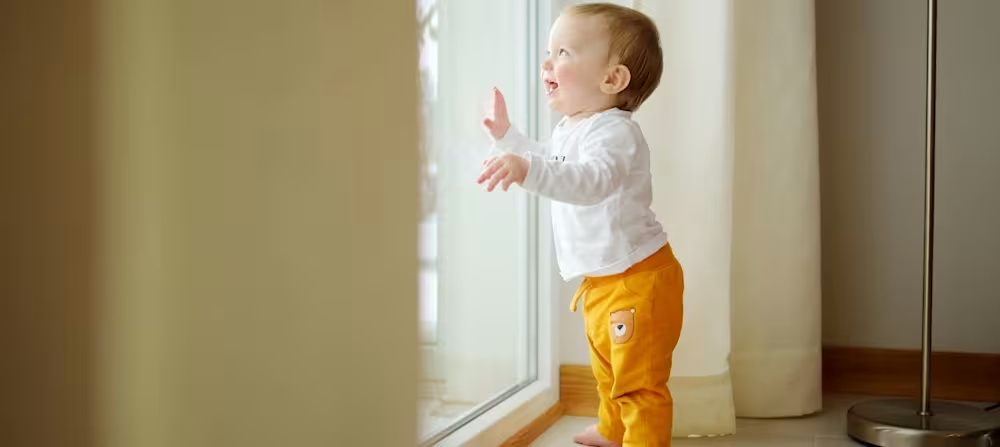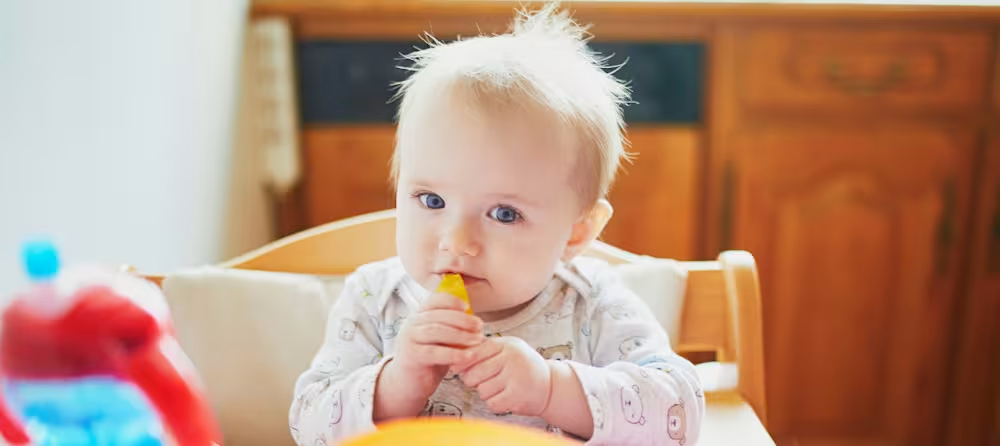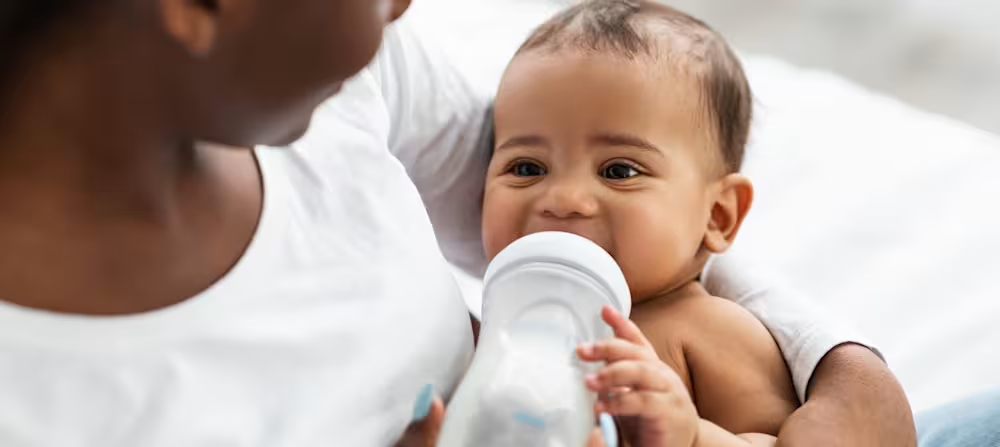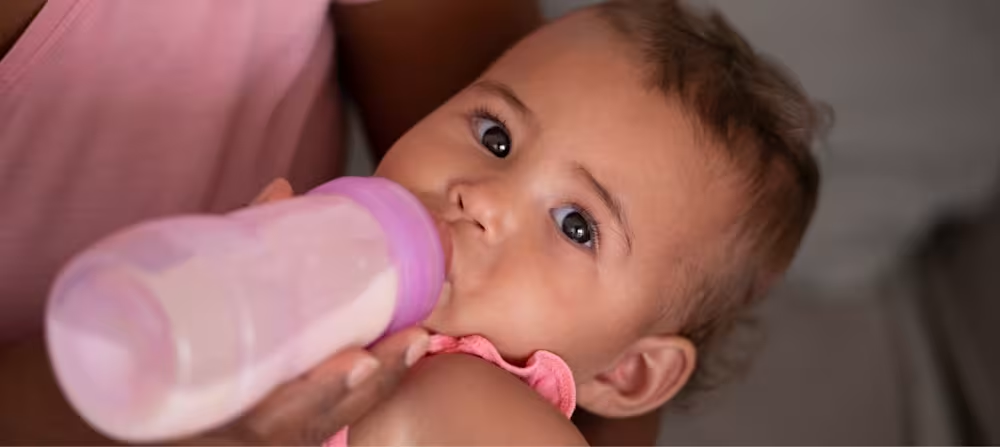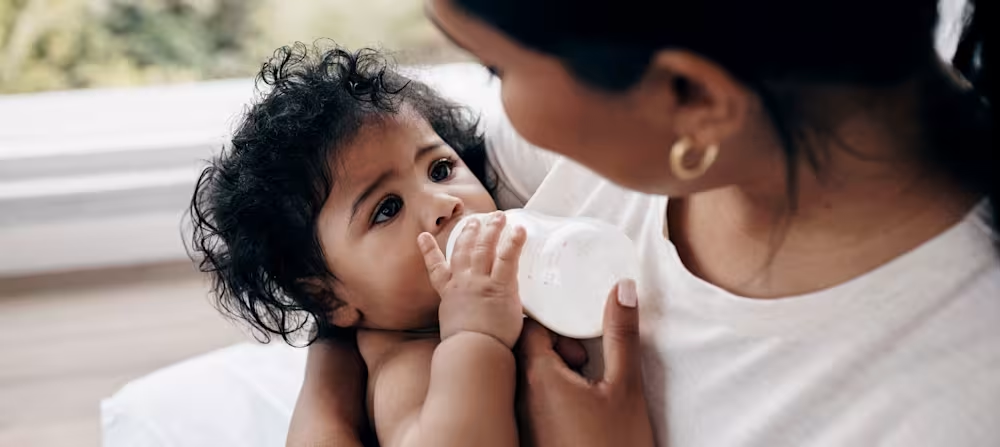When do babies hold their own bottle for the first time?
Updated Dec 29, 2025

As babies grow in the second half of their first year, they begin learning how to feed themselves. For bottle-fed babies, one of these milestones is often holding their own bottle. Around the same time, little ones can also start practicing drinking with an open cup.
In this article, we’ll walk you through at what age babies hold their own bottle, give you tips for encouraging this milestone, and let you know what comes next on the path to self-feeding.
When do babies start holding their own bottle?
It’s exciting when your little one gains some independence and can start to practice feeding themselves, although it’s bittersweet too — they grow so fast! Here’s when you may expect your child to start holding their own bottle and/or cup.
Hold their own bottle: Babies can typically start holding their own bottle around 6 - 9 months []. However, there’s a range of normal when it comes to this skill, so your little one may be able to do this sooner or later depending on factors like their core and arm strength, fine motor skills, and hand-eye coordination.
Note that even when your baby is able to hold their own bottle, you should be close by to supervise the feed. Before that, never use something (a device or other object like a rolled-up blanket) to prop a bottle and let your baby feed alone, according to the American Academy of Pediatrics []. Doing so is unsafe because your little one could choke or the bottle could slip away. Having a baby hold their own bottle also removes the bonding factor from feeding. Even though feeding your child takes up a lot of time, those snuggles are priceless! Propping a bottle can also increase the risk of ear infections [].
Around 9 - 12 months, children can usually hold a cup with both hands and bring it to their mouth. At this age, a child can usually sit upright without support so they will develop proximal stability that allows for increased development of the distal extremities (parts of the body that further away from the center of the body, like hands).
Then, around 12 - 15 months, a toddler may be able to lift and drink from a cup with one hand as development goes from symmetrical movements (picking up a bottle to drink) to reciprocal movements (using one hand to pickup food and another to pickup food the next time).
Hold their own cup: If you are breastfeeding and your baby doesn’t use bottles, you can introduce them to an open cup instead (with a small amount of breast milk) at around 6 months [] — though they'll likely need assistance at this age. Bottle-fed babies can also begin to practice drinking formula or breast milk out of an open cup around this time as well.
Putting formula or breast milk in a cup may feel more natural [] for little ones at first since this is what they’re used to drinking. However, you can also use plain water for babies, especially as they grow more comfortable with cups.
Why do babies hold their own bottle?
Feeding development:
An important part of child development includes babies learning to feed themselves. A large piece of that self-feeding journey is starting solids, of course, but learning to drink from a bottle and/or cup is a big deal too! On top of that, it’s convenient for parents to be able to eventually hand over a bottle to their child.
Physical development:
Drinking from a bottle or cup on their own is also a marker of a child’s motor development. These typically include the core strength to sit up to drink, the fine motor skills required to hold onto a bottle or cup, and hand-eye coordination to bring it to their mouth. Bilateral coordination (the ability to use both sides of the body in a coordinated way at the same time) is also a factor.
Cognitive development:
In the first few months of life [], babies learn that a feeding of breast milk or formula satisfies hunger. They also learn to recognize that a bottle (or cup) is a tool for feeding and can anticipate that a feeding is coming when they see it.
Ways to encourage baby to hold their own bottle?
Tip #1: Show baby how to hold the bottle
A great way to help your little one learn to hold a bottle is by showing them! Demonstrate this for your baby and then hand it over so they can try. Lots of modeling is great for little ones. You can also try guiding the bottle [] toward their mouth as they hold on.
Tip #2: Have your little one practice holding onto toys
Help set your baby up for success by encouraging them to grasp onto other toys with two hands and bring them to their mouth. Mastering symmetrical movements can help them with a bottle. Babies also learn through repetition! []
Tip #3: Start small!
A full bottle may be heavy for little hands. Start with a small amount of breast milk or formula in a bottle and let them practice. You can also try with an empty bottle but this may be frustrating for a child who’s expecting a meal.
Tip #4: Set realistic expectations
Even if your little one reaches for the bottle and expresses interest in holding it, they may not be quite ready to do it all on their own yet. This skill takes practice (and careful supervision). It’s perfectly normal if it takes a while for them to be able to hold their own bottle for a full feeding.
It will likely take even more practice for a young child to be able to drink well from an open cup. The AAP suggests that children transition from a sippy cup to an open cup around 2 [], so they have plenty of time! Practice now will help build the foundation for future eating skills and boost their confidence.
Baby not holding their own bottle: What to do
Remember that all babies learn and grow at their own pace. Some babies may not be motivated to hold their own bottle at first, others may need more time to develop the strength and coordination to do so, while others don’t ever take a bottle — that’s fine too! When it comes to holding their own bottle, so long as you don’t have concerns about your child’s development in other related areas, there is probably little reason to worry.
However, you know your baby best! If you notice any red flags or have concerns about their feeding milestones, growth, or development, consult their pediatrician.
Holding their own bottle unlocked: What's the next step?
In the second half of an infant’s first year of life, there are usually many exciting feeding milestones as your little one begins to eat solid food and learns the skills of eating. Here’s how the progression may look:
Introduction to solids
If your little one starts holding their own bottle on the early end of the spectrum, this milestone may coincide with their introduction to solid foods. Babies typically begin dabbling in the realm of solid foods at around 6 months old and once they’re showing appropriate signs of readiness [], such as being able to hold their head up and sit up independently. There are many , though currently the most popular are the traditional and .
Pincer grasp
Some babies are closer to 9 months when they begin holding their own bottle. Around this age, infants are able to use their hands in new and exciting ways thanks to the development of their (using their thumb and pointer finger together). This allows them to pick up small pieces of food which makes it easier for little ones to feed themselves.
Intro to cups and transition away from bottles
Introducing children to different kinds of cups at an early age can help prepare them for an eventual transition away from bottles. When you go to the store (or browse Amazon) to pick one out, it’s easy to be overwhelmed by the options. If you prefer the “sippy” cup route, the AAP recommends [] picking a cup without a valve (that requires a child to suck on it to get liquid out, like a bottle) and has a snap-on or screw-on lid with a simple spout. One that has two handles may be easier for children to hold onto.
In general, sippy cups are an optional stepping stone to having your child drink from an open cup so try not to get too caught up in picking the “perfect” cup for your little one. It’s perfectly fine to go straight to practice with an open cup instead, though this can be trickier when it comes to spills, especially if you’re on the go.
As your baby gets used to drinking breast milk, formula, or water from a cup, the AAP recommends that they wean from bottles between 12 - 18 months []. Allowing children to bottle-feed for longer can lead to issues like an increase in cavities, skipped solid food meals, and more attachment to the bottle which makes it harder to give up later. Keep in mind that this transition away from bottles can be tricky for little ones. Gradually eliminating [] bottles can make eliminating bottles go more smoothly, as well as offering extra snuggles and comfort to your child during this time.
Takeaway
If your baby takes a bottle, you may expect them to start holding (or wanting to hold) their own bottle at around 7 - 9 months old []. If your infant doesn’t use bottles, you may consider having them practice drinking from cups starting at around this age instead. The AAP recommends [] babies begin using open cups at around 6 months old and then transitioning away from bottles by age 12 - 18 months.
You can encourage your child to hold their own bottle (or cup) by modeling the skill for them. Also, consider starting small with just a little formula or breast milk to avoid spills and making the bottle too heavy for your little one. Be patient and set realistic expectations when it comes to these skills — it’s normal for feeding skills to improve with time and practice.
Some children may not be interested in holding their own bottle. This is typically not a problem unless you’re seeing related red flags or developmental delays. If you have concerns about your baby’s feeding or motor development, reach out to their pediatrician.
Holding their own bottle is one of many feeding milestones your child will likely meet as they approach their first birthday. As babies grow, they can be introduced to a wide variety of foods and textures and will be able to use their pincer grasp to pick up small pieces of food at around 9 months.
Share article:
Note: The content on this site is for informational purposes only and should not replace medical advice from your doctor, pediatrician, or medical professional. If you have questions or concerns, you should contact a medical professional.
9 Sources
Share article:
